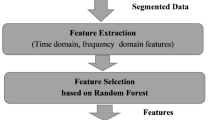Abstract
Human activity recognition aims to identify the activities carried out by a person. Recognition is possible by using information that is retrieved from numerous physiological signals by attaching sensors to the subject’s body. Lately, sensors like accelerometer and gyroscope are built-in inside the Smartphone itself, which makes activity recognition very simple. To make the activity recognition system work properly in smartphone which has power constraint, it is very essential to use an optimization technique which can reduce the number of features used in the dataset with less time consumption. In this paper, we have proposed a dimensionality reduction technique called fast feature dimensionality reduction technique (FFDRT). A dataset (UCI HAR repository) available in the public domain is used in this work. Results from this study shows that the fast feature dimensionality reduction technique applied for the dataset has reduced the number of features from 561 to 66, while maintaining the activity recognition accuracy at 98.72% using random forest classifier and time consumption in dimensionality reduction stage using FFDRT is much below the state of the art techniques.








Similar content being viewed by others
References
Akhavian R, Behzadan AH (2016) Smartphone-based construction workers activity recognition and classification. Autom Constr 71:198–209
Alveraz de la Concepcion MA et al (2017) Mobile activity recognition and fall detection system for elderly people using Ameva algorithm. Pervasive Mob Comput 34:3–13
Anguita D et al (2012) Human activity recognition on smartphones using a multiclass hardware-friendly support vector machine. Springer lecture notes in computer science, pp 216–223
Anguita D et al (2013) Energy efficient smartphone-based activity recognition using fixed-point arithmetic. J Univers Comput Sci 19:1295–1314
Asteriadis S, Daras P (2017) Landmark-based multimodal human action recognition. Multimed Tools Appl 76:4505–4521
Bayat A et al (2014) A study on human activity recognition using accelerometer data from smartphones. Proc Comput Sci 34:450–457
Cao L et al (2017) GCHAR: an efficient group-based contextaware human activity recognition on smartphone. J Parallel Distrib Comput 118:67–80
Catal C et al (2015) On the use of ensemble of classifiers for accelerometer-based activity recognition. Appl Soft Comput 37:1–5
Chen C et al (2016) Real-time human action recognition based on depth motion maps. J. Real-Time Image Process 12:155–163
Chetty G et al (2015) Smart phone based data mining for human activity recognition. Proc Comput Sci 46:1181–1187
Dao MS et al (2017) Daily human activities recognition using heterogeneous sensors from smartphones. Proc Comput Sci 111:323–328
Doewes A et al (2017) Feature selection on human activity recognition dataset using minimum redundancy maximum relevance. In: IEEE international conference on consumer electronics, Taiwan, pp 171–172
Francis DP et al (2017) Empirical evaluation of kernel pca approximation methods in classification tasks. arXiv:1712.04196
Goldberger J et al (2005) Neighbourhood components analysis. Advances in neural information processing systems, vol 17. MIT Press, Cambridge, pp 513–520
Jain A, Kanhangad V (2016) Investigating gender recognition in smartphones using accelerometer and gyroscope sensor readings. In: IEEE international conference on computational techniques in information and communication technologies (ICCTICT), pp 597–602
Jansi R, Amutha R (2018) A novel chaotic map based compressive classification scheme for human activity recognition using a tri-axial accelerometer. Multimed Tools Appl 77(23):31261–31280
Kira K, Rendall LA (1992) The feature selection problem: traditional methods and a new algorithm. In: AAAI-92 proceedings, pp 129–134
Kwon Y et al (2014) Unsupervised learning for human activity recognition using smartphone sensors. Expert Syst Appl 41:6067–6074
Meng H et al (2008) Real-time human action recognition on an embedded, reconfigurable video processing architecture. J Real-Time Image Process 3:163–176
Partridge M, Calvo RA (1998) Fast dimensionality reduction and simple PCA. Intell Data Anal 2:203–214
Reyes-Ortiz J et al (2015) Human activity and motion disorder recognition: towards smarter interactive cognitive environments. In: ESANN 2013 proceedings. Computational intelligence and machine learning, pp 403–412
Reyes-ortiz J et al (2016) Transition-aware human activity recognition using smartphones. Neurocomputing 171:754–767
Ronao CA, Cho SB (2016) Human activity recognition with smartphone sensors using deep learning neural networks. Expert Syst Appl 59:235–244
San-Segundo R et al (2016a) Human activity monitoring based on hidden Markov models using a smartphone. IEEE Instrum Meas Mag 19:27–31
San-Segundo R et al (2016b) Segmenting human activities based on HMMs using smartphone inertial sensors. Pervasive Mob Comput 30:84–96
San-Segundo R et al (2016c) Feature extraction from smartphone inertial signals for human activity segmentation. Signal Process 120:359–372
Su X et al (2014) Activity recognition with smartphone sensors. Tsinghua Sci Technol 19:235–249
Tran DN, Phan DD (2016) Human Activities recognition in android smartphone using support vector machine. In: IEEE international conference on intelligent systems, modelling and simulation, pp 64–68
Walse KH et al (2016) PCA based optimal ANN classifiers for human activity recognition using mobile sensors data. In: Proceedings of first international conference on information and communication technology for intelligent systems, vol 1. Springer, Cham, pp 429–436
Wang Z et al (2016) Application of Relieff algorithm to selecting feature sets for classification of high resolution remote sensing image. In: IEEE international geoscience and remote sensing symposium, pp 755–758
Yang W et al (2012a) Fast neighborhood component analysis. Neurocomputing 83:31–37
Yang W et al (2012b) Neighborhood component feature selection for high-dimensional data. J Comput 7:161–168
Zhang K, Zhang L (2018) Extracting hierarchical spatial and temporal features for human action recognition. Multimed Tools Appl 77:16053–16068
Author information
Authors and Affiliations
Corresponding author
Ethics declarations
Conflict of interest
The authors declare that they have no conflict of interest.
Additional information
Publisher's Note
Springer Nature remains neutral with regard to jurisdictional claims in published maps and institutional affiliations.
Rights and permissions
About this article
Cite this article
Mohammed Hashim, B.A., Amutha, R. Human activity recognition based on smartphone using fast feature dimensionality reduction technique. J Ambient Intell Human Comput 12, 2365–2374 (2021). https://doi.org/10.1007/s12652-020-02351-x
Received:
Accepted:
Published:
Issue Date:
DOI: https://doi.org/10.1007/s12652-020-02351-x




